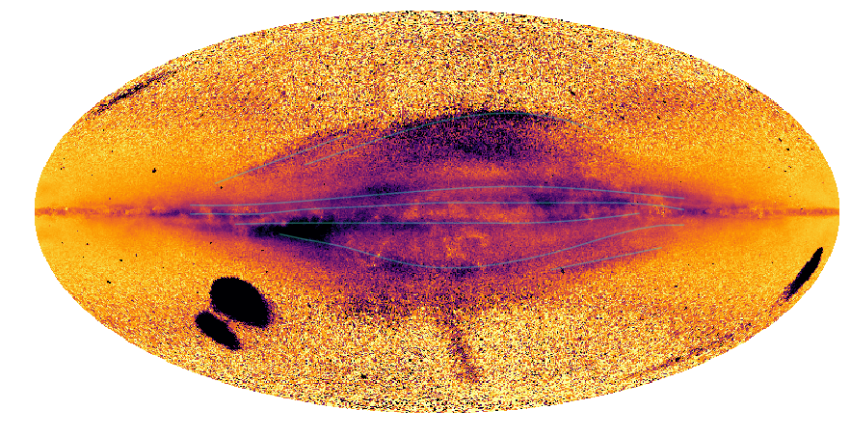An international team of astronomers, led by researcher Chervin Laporte of the Institute of Cosmos Sciences of the University of Barcelona (ICCUB-IEEC), has used data from the Gaia space mission to create a new map of the Milky Way’s outer disc. Intriguingly, newly found structures include evidence for fossil spiral arms. The team published the new work in a paper in Monthly Notices of the Royal Astronomical Society: Letters.
The team analysed the Gaia motion data, available from December 2020, to identify coherent structures. Their resulting map revealed the existence of many previously unknown spinning filamentary structures at the edge of the disc. It also gave a sharper overall view of previously known structures. Numerical simulations predict such filamentary structures to form in the outer disc from past satellite interactions, but the sheer quantity of substructure revealed by this map was not expected and remains a mystery.
What could these structures possibly be? One possibility is that they are the remains of tidal arms from the Milky Way disc which were excited at different times by various satellite galaxies. Our Galaxy is now surrounded by 50 of these satellites and has engulfed numerous other galaxies in its past. At present, the Milky Way is thought to be being perturbed by the Sagittarius dwarf galaxy, But in its more distant past it interacted with another intruder, the Gaia Sausage, which has now dispersed its debris into the outskirts of our galaxy.
In an earlier study, the same team showed that one of the filamentary structures in the outer disc, the Anticenter Stream, had stars which were predominantly more than 8 billion years old. This makes it potentially too old to have been excited by Sagittarius alone and instead points to the Gaia Sausage.
Another possibility is that not all these structures are actual genuine fossil spiral arms but instead form the crests of large scale vertical distortions in the Milky Way disc. “We believe that discs respond to satellite impacts which set up vertical waves that propagate like ripples on a pond" says Laporte.
To try to distinguish between the two explanations, the team has now secured a dedicated follow-up programme with the William Herschel Telescope on the Canary Islands in order to study the properties of the stellar populations in each substructure. Future surveys will help shed light on the nature and origin of these heavenly wispy structures.
Laporte comments on their findings: “Typically this region of the Milky Way has remained poorly explored due to the intervening dust which severely obscures most of the Galactic midplane”. He adds, “While dust affects the luminosity of a star, its motion remains unaffected. We were certainly very excited to see that the Gaia motions data helped us uncover these filamentary structures! Now the challenge remains to figure what these things exactly are, how they came to be, why in such large numbers, and what they can tell us about the Milky Way, its formation and evolution."
Media Contacts
Dr Robert Massey
Royal Astronomical Society
Mob: +44 (0)7802 877 699
press@ras.ac.uk
Gurjeet Kahlon
Royal Astronomical Society
Mob: +44 (0) 7802 877 700
press@ras.ac.uk
Science Contacts
Dr Chervin F. P. Laporte
Distinguished Researcher / ERC Group Leader
Institute of Cosmos Sciences, University of Barcelona
chervin.laporte@icc.ub.edu
Professor Sergey E. Koposov
Reader in Observational Astronomy, University of Edinburgh
Affiliated Associate Professor, University of Cambridge
Royal Observatory, Edinburgh
sergey.koposov@ed.ac.uk
Professor Vasily Belokurov
Professor of Astronomy
Institute of Astronomy, University of Cambridge
vasily@ast.cam.ac.uk
Further information
The research appears in ‘Kinematics beats dust: unveiling nested substructure in the perturbed outer disc of the Milky Way’, Monthly Notices of the Royal Astronomical Society: Letters, C. F. P. Laporte, S. E. Koposov, V. Belokurov
A copy of the letter is available from https://academic.oup.com/mnrasl/advance-article-abstract/doi/10.1093/mnrasl/slab109/6400111?redirectedFrom=fulltext
Notes for Editors
The Royal Astronomical Society (RAS), founded in 1820, encourages and promotes the study of astronomy, solar-system science, geophysics and closely related branches of science. The RAS organises scientific meetings, publishes international research and review journals, recognises outstanding achievements by the award of medals and prizes, maintains an extensive library, supports education through grants and outreach activities and represents UK astronomy nationally and internationally. Its more than 4,000 members (Fellows), a third based overseas, include scientific researchers in universities, observatories and laboratories as well as historians of astronomy and others.
The RAS accepts papers for its journals based on the principle of peer review, in which fellow experts on the editorial boards accept the paper as worth considering. The Society issues press releases based on a similar principle, but the organisations and scientists concerned have overall responsibility for their content.
Keep up with the RAS on Twitter, Facebook, Instagram, LinkedIn, and YouTube.


